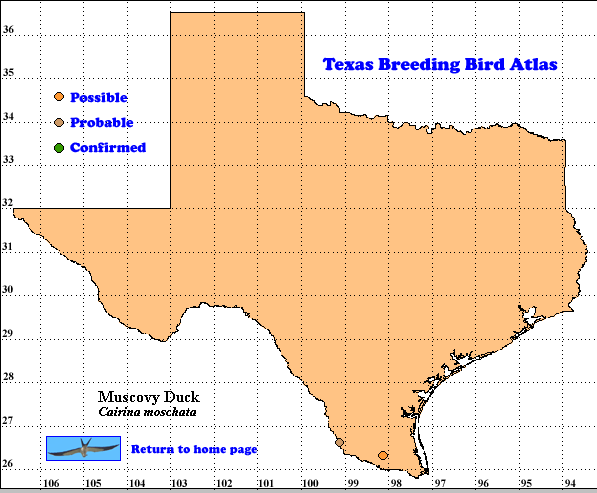Anas platyrhynchos diazi
Because this form is identifiable, the TBBA project surveyed it separately from the “typical” Mallard..
Mexican Duck and other “Mallard-like” ducks whose male plumages resemble those of female, immature and eclipse male “typical” Mallards, have always raised intriguing taxonomic questions. A recent genetic study of dabbling ducks (Johnson and Sorenson 1999) shows the close relationship of Mottled (A. fulvigula) and American Black duck (A. rubripes) to the North American Mallard (A. platyrhynchos).
Mexican Duck was considered a separate species for almost a century, but is now treated as a subspecies of the “typical” Mallard because of extensive hybridization along the United States-Mexico border (Am. Ornithol. Union 1998). The status of other species, also closely related to Mallards, was left unchanged although they also hybridize widely with “typical” Mallards and can be difficult to sort out (Fedynich and Rhodes 1995). A study of plumage and morphological differences in Mexican Ducks across their range indicates a clinal variation from north to south with many areas where these ducks show no evidence of hybridization (Scott and Reynolds 1983). A recent genetic study (McCracken et al. 2001) suggests Mexican Ducks are most closely related to Mottled Ducks and these two are most closely related to American Black Ducks. These authors and others (Howell and Webb 1995) suggest Mexican Duck deserves full species status. A more detailed discussion of the taxonomy of Mexican Duck is presented in the Systematics section of Drilling et al. (2002).
DISTRIBUTION. During the 1987-1992 field work seasons of the TBBA project, volunteers found 4 confirmed, 15 probable and 4 possible breeding sites for Mexican Ducks, almost all in the Trans-Pecos region (see the region map in Lockwood and Freeman [2004]). In the United States, these ducks also breed in south east Arizona (Corman 2005), and southern New Mexico (Am. Ornithol. Union 1998). They are resident in Mexico from Arizona and New Mexico south on the central plateau to the central volcanic belt (Howell and Webb 1995).
SEASONAL OCCURRENCE. Mexican Ducks are resident in their breeding range (Oberholser 1974, Lockwood and Freeman 2004). Many Mexican Duck pairs bond or re-bond by September in Arizona, earlier than “typical” Mallards. In that state, a nest with eggs was discovered April 25 with an adult with downy young observed as late as mid-September (Swarbrick 1975, Corman 2005).
BREEDING HABITAT. In Texas Mexican Ducks are found in rivers, ponds, shallow lakes and irrigation ditches lined with emergent vegetation (Oberholser 1974). The well-hidden nest, placed on the ground, is built of grasses and lined with down. In this nest the female lays 4-9 very pale green eggs (Harrison 1979). Many details of breeding ecology are probably similar to those of Mottled Ducks, such as an average incubation period of 26 days (Johnson circa.1998).
STATUS. Mexican Ducks are rare to locally common residents in the Trans-Pecos (Lockwood and Freeman 2004) where Oberholser (1974) reported them to be.locally uncommon to rare. A program of release of captive-raised Mexican Ducks by the New Mexico Fish and Game Department in the 1960s and 1970s resulted in an estimated population of 100-150 in Texas in 1975 (Harrison 1979). Hybridization with wild or feral “typical” Mallards has made most or all of the Texas population intergrades (Lockwood and Freeman 2004). While the exact status of these birds remains a matter of controversy, Texas birdwatchers can still enjoy the presence of these identifiable birds.
Text by Robert C. Tweit (2008)
Literature cited.
American Ornithologists’ Union. 1998. Checklist of North American birds, 7th ed. Am, Ornithol. Union, Washington, DC.
Corman, T. E. 2005. Mallard (Anas platyrhynchos). In Arizona breeding bird atlas. pp. 58-59 (T. E. Corman and C. Wise-Gervais, eds.), University of New Mexico Press, Albuquerque.
Drilling, N., R. Titman and F. McKinney. 2002. Mallard (Anas platyrhynchos), The Birds of North America Online (A. Poole, Ed.). Ithaca: Cornell Lab of Ornithology; Retrieved from: http://bna.birds.cornell.edu/bna/species/658
Fedynich, A. M. and O. E. Rhodes. 1995. Mallard-like ducks in the Playa Lakes region. Wilson Bull. 107: 548-551.
Harrison, H. H. 1979. A field guide to western birds’ nests. Houghton Mifflin, Boston, MA.
Howell, S. N. G. and S. Webb. 1995. A guide to the birds of Mexico and northern Central America. Oxford University Press, New York.
Johnson, K. P. and M. D. Sorenson.1999. Phylogeny and biogeography of dabbling ducks (Genus Anus): a comparison of molecular and morphological evidence. Auk 116: 792-805.
Johnson, W. P. ca. 1998. .. Mottled Duck (Anas. fulvigula). In Texas breeding bird atlas (K.A. Arnold and K. L. P. Benson, eds.). Retrieved from: http://txtbba.tamu.edu/accounts/modu/moduacc
Lockwood, M. W. and B. Freeman. 2004. The TOS handbook of Texas birds. Texas A&M University Press, College Station.
McCracken, K., W. P. Johnson and F. H. Sheldon. 2001. Molecular population genetics, phylogeography, and conservation biology of the Mottled Duck (Anas fulvigula ). Conserv. Genet. 2: 87–102.
Oberholser, H. C. 1974. The bird life of Texas. University of Texas Press, Austin.
Scott, N. J., Jr. and R.P. Reynolds. 1984. Phenotypic variation of the Mexican Duck (Anas platyrhynchos diazi) in Mexico. Condor 86: 266-274.
Swarbrick, B. M. 1975. Ecology of the Mexican Duck in the Sulphur Springs Valley of Arizona. M. S. thesis, University of Arizona, Tucson.
